-
Membership
Membership
Anyone with an interest in the history of the built environment is welcome to join the Society of Architectural Historians -
Conferences
Conferences
SAH Annual International Conferences bring members together for scholarly exchange and networking -
Publications
Publications
Through print and digital publications, SAH documents the history of the built environment and disseminates scholarship -
Programs
Programs
SAH promotes meaningful engagement with the history of the built environment through its programsMember Programs
-
Jobs & Opportunities
Jobs & Opportunities
SAH provides resources, fellowships, and grants to help further your career and professional life -
Support
Support
We invite you to support the educational mission of SAH by making a gift, becoming a member, or volunteering -
About
About
SAH promotes the study, interpretation, and conservation of the built environment worldwide for the benefit of all
SAH Announces Strategic Planning Committee
Sep 8, 2021
by
SAH News
The Society of Architectural Historians is pleased to announce the members of the SAH Strategic Planning Committee, charged with developing the Society’s vision and guiding principles for the next five years.
The Strategic Planning Committee, chaired by SAH First Vice President Patricia Morton, will begin meeting this month and will seek input from SAH members through a needs assessment survey, virtual listening sessions, and meetings at the SAH 2022 Annual International Conference in Pittsburgh. The Committee will also review SAH’s current practices, identify strategic issues, analyze the current state of SAH’s mission, establish priorities, recommend outcomes, and formulate a strategic plan for achieving its goals. The SAH IDEAS Initiative will inform all aspects of the strategic planning process. The strategic plan will be finalized and shared with members in April 2023.
The SAH Strategic Planning Committee members are:
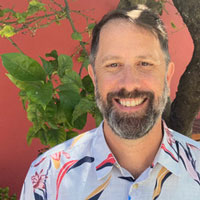 Daniel A. Barber
Daniel A. Barber
Daniel A. Barber is Associate Professor and Chair of the PhD Program in Architecture at the University of Pennsylvania. His research and teaching narrate environmental histories of architecture and explore pathways into the post-hydrocarbon future, including though his books Modern Architecture and Climate: Design before Air Conditioning (Princeton University Press, 2020) and A House in the Sun: Modern Architecture and Solar Energy in the Cold War (Oxford University Press, 2016) and essays and articles such as “After Comfort” (Log 2019). Barber edits the accumulation series on e-flux architecture and is co-founder of Current: Collective on Environment and Architectural History. He has held fellowships at Harvard and Princeton universities and the Alexander von Humboldt Foundation.
Barber is currently a Senior Fellow at the Käte Hamburger Centre for Apocalyptic and Post-Apocalyptic Studies at Universität Heidelberg, where he is working on two projects: Thermal Practice explores how architects and inhabitants co-create the thermal conditions of the built interior; Architecture of the Aftermath considers the role of architecture in mediating the climate crisis. Both draw on a combination of archival and technological research methods as they seek to reconsider the history of architecture with energy and climate in the foreground.
He is co-chair of the SAH Climate Change and Architectural History Affiliate Group.
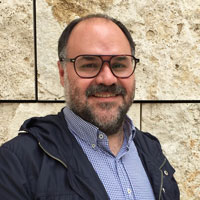 César Bargues Ballester
César Bargues Ballester
César Bargues Ballester is trained in architecture, historic preservation, and business disciplines and has professional and research experience in the United States and Spain. In 2018, Bargues Ballester joined the Getty Conservation Institute, where he is involved with several projects associated with the Conserving Modern Architecture Initiative. He has also served as a member of the Diversity, Equity, Accessibility, and Inclusion Task Force and is deeply involved in monitoring and evaluation processes. Before joining the Getty Conservation Institute, he worked at Integrated Conservation Resources and was a research associate in the formerly known Architectural Conservation Laboratory, where he engaged in architectural history, heritage documentation, material conservation, and management planning, including creating a conservation management plan for the Arts Building of the noted woodworker George Nakashima and a Historic Structure Report for Jackson Lake Lodge, funded by the Getty Keeping It Modern grant program and the National Park Service, respectively. Bargues Ballester holds a Master in Architecture from the Universitat Politècnica de València in Spain and a Master of Science in Historic Preservation from the University of Pennsylvania.
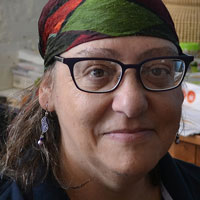 Gail Dubrow
Gail Dubrow
Gail Dubrow is Professor of Architecture and History at University of Minnesota, where she teaches in the Heritage Studies and Public History Program. She is the author of Sento at Sixth and Main, with Donna Graves, and Restoring Women’s History Through Historic Preservation, coedited with Jennifer Goodman. She is currently writing a book about the earliest architects of Japanese ancestry to practice in the United States. This project has been supported by fellowships from the American Council of Learned Societies, the Huntington Library, and the Smithsonian Institution.
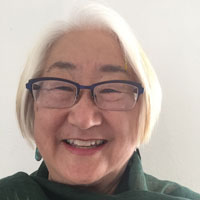 Lynne Horiuchi
Lynne Horiuchi
Lynne Horiuchi is an independent scholar who received her PhD in 2005 from the University of California at Santa Barbara. She has published numerous articles on the built environments of Japanese American incarceration. Race, space, architecture, and ethics are her theoretical interests crossing over into Asian American studies, art history, vernacular architecture, urban planning, and critical race studies. She has co-edited a volume with Tanu Sankalia, Urban Reinventions: San Francisco’s Treasure Island, that examines the complete transformations of a man-made island for a world exposition, a military base, and a new neighborhood in San Francisco. She is co-writing with Anoma Pieris a volume on imprisonment during World War II from Singapore to North America, The Architecture of Confinement: Incarceration Camps of the Pacific War. She is completing a volume, Dislocations and Relocations: The Planning, Design, and Construction of Prison Cities, that interrogates the relationships between architecture and vernacular building and military design and construction. Horiuchi has received numerous awards including NEH grants and a Civil Liberties Public Education Fellowship and was named a National Endowment for the Arts MacDowell Fellow. She has taught at the University of North Carolina in the Department or Architecture, and she is currently developing a course on race, redevelopment, and gentrification for the Future Histories Lab at the University of California at Berkeley. She has served on the board of the Rosie the Riveter Trust and numerous other community organizations and committees. A long-time member of SAH, she currently serves as SAH secretary, co-chair of the SAH Minority Scholars Affiliate Group, and as a member of the SAH IDEAS Committee.
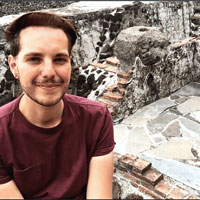 Anthony Meyer
Anthony Meyer
Anthony Meyer is a PhD Candidate in the Department of Art History at the University of California, Los Angeles, where he specializes in the Indigenous arts of the Americas and the global Early Modern. While at UCLA, Meyer has participated in collaborative projects such as Early Modern Conversions and Making Worlds at McGill University, as well as assisted an international exhibition on Maya art at the Los Angeles County Museum of Art. Currently, Meyer coordinates the Cotsen Institute of Archaeology’s Architecture Lab and co-organizes the Indigenous Material and Visual Culture of the Americas Working Group with the Center for 17th- & 18th-Century Studies. Meyer is excited to contribute his experience in shaping the future of SAH.
Meyer’s fieldwork has spanned time and space, including pre-Invasion sculpture from the Cauca Valley in Colombia, contemporary Mapuche artists in Chile, Nahua religious art and architecture in Mexico, and the reception of Mexica objects in 16th-century Europe. His dissertation, “The Givers of Things: Nahua Religious Leaders and the Art of Making Gifts in the Mexica and Early Modern Worlds,” confronts the colonial erasure of Nahua religious leaders (tlamacazque) by examining the material and spatial roles these key makers played in the Mexica (A.D. 1325–1521) and Early Modern worlds. For his research, Meyer has received fellowships from the Center for the Advanced Study in the Visual Arts, the Fulbright Association, the Huntington Library, the John Carter Brown Library, the Renaissance Society of America, the Society of Architectural Historians, and the Social Science Research Council.
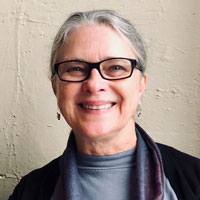 Patricia A. Morton, Chair
Patricia A. Morton, Chair
Patricia A. Morton is Associate Professor in the Media and Cultural Studies Department and Chair of the Urban Studies Program at the University of California, Riverside. She is author of Hybrid Modernities: Architecture and Representation at the 1931 International Colonial Exposition in Paris (MIT Press), which examines the representation of racial hierarchies at a world’s fair staged to celebrate colonialism. She has lectured and published widely on architectural history and race, gender and identity, including her essay, “Decolonizing the ACHAC Collection,” in Visualizing Empire: Africa, France, and the Politics of Representation, edited by Dominic Thomas, Steven Nelson, and Rebecca Peabody (Getty Publications, 2020). Her current project, Paying for the Public Life, analyzes written and built work by architect Charles W. Moore and his collaborators to trace the transformation of public space in postwar United States. A forthcoming article, “Public Life and Public Housing: Charles Moore’s Church Street South,” examines the racial thinking fundamental to Moore’s public housing project for Black residents displaced by Urban Renewal. She is a past editor of the Journal of the Society of Architectural Historians and currently serves as First Vice President of the Society of Architectural Historians.
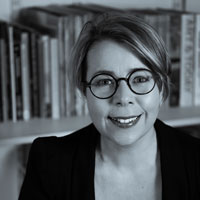 Tanja Poppelreuter
Tanja Poppelreuter
Tanja Poppelreuter is a Lecturer in Architectural History and Theory and Director of Postgraduate Research Studies in the Built Environment at the University of Salford, Manchester. Her research interests lie in the field of 20th-century art and architectural theory with a focus on the impact of politics, gender, exile, as well as spatial perception on these fields. Her work shifts the attention from the architectural object to architects’ intentions for the composition of spatial experiences and to theories on the transformative capabilities of space on the human mind. This is addressed in publications such as Das Neue Bauen für den Neuen Menschen (2007), “Social-Individualism” (2011), “Sensation of Space and Modern Architecture” (2012), “Raumplan after Loos” (2015) and “Spaces for the elevated personal life” (2016). Other publications consider the experiences of exiled women with an education in architecture. This research analyzes the cultural and professional challenges associated with exile and draws on theoretical frameworks within gender studies and exile studies to suggest an alternative focus when developing historiography. In concentrating on transnational networks, events, actors, and architecture, this research is discussed in papers such as “Women Architects in Exile: Methodological Challenges in Historiography” (2021), “Sustaining Independence” (2021), and “This is not a Success Story” (2021).
Poppelreuter is a member of the Board of Advisors of the International Archives of Women in Architecture (IAWA) in Blacksburg, Virginia; the Historic Buildings Council, Belfast, Northern Ireland; and the Equality, Diversity, and Inclusivity (EDI) group of the RIBA Northwest in Liverpool, UK.
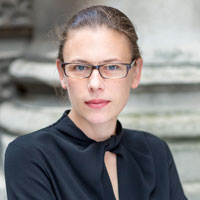 Robin Schuldenfrei
Robin Schuldenfrei
Robin Schuldenfrei is the Tangen Senior Lecturer in 20th Century Modernism at The Courtauld Institute of Art, University of London. She has written widely on modernism as it intersects with theories of the object, architecture, and space. Her publications include Luxury and Modernism: Architecture and the Object in Germany 1900–1933 (Princeton University Press, 2018) as well as numerous articles, essays and edited volumes, including Iteration: Episodes in the Mediation of Art and Architecture (2020), Atomic Dwelling: Anxiety, Domesticity, and Postwar Architecture (2012) and, co-edited with Jeffrey Saletnik, Bauhaus Construct: Fashioning Identity, Discourse, and Modernism (2009). She is currently writing a book on objects in exile and the displacement of design. Schuldenfrei is committed to advancing broad, interdisciplinary conversations that are crucial for the liberal arts’ grappling with the protracted problems of our time. She is an active member in the UK-based collective Unsettled Subjects, which seeks to impact architectural history and architecture as a practice in actively decolonizing teaching, research, and the built environment around us, through the investigation of a broad set of issues and questions concerning identity, race, ethnicity, gender, sexuality, class, and power.
 Kylie Seltzer
Kylie Seltzer
Kylie Seltzer is a researcher, educator, digital enthusiast, and community builder whose work focuses on dismantling white supremacy and creating a more equitable world. Her scholarly work analyzes the intersection of race theory and architecture in the built environment, and she received her PhD from the University of Pittsburgh in 2020. Her innovative doctoral research was recognized through grants from the Graham Foundation, Council for European Studies, and the American Council of Learned Societies. She currently works as the Research Strategist at Common Cause Consultants, where she uses her expertise to address the urgent inequities that plague Pittsburgh residents.
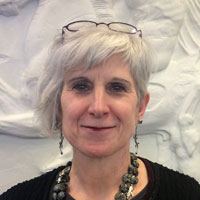 Ann Baird Whiteside
Ann Baird Whiteside
Ann Baird Whiteside is Assistant Dean for Information Services at the Harvard University Graduate School of Design. Her focus is expanding the use of digital resources in close collaboration with scholars and the use of technology to support teaching and research through the Frances Loeb Library. She is project lead for the GSD’s African American Design Nexus, a GSD community-driven network that highlights the important contributions of African American design leaders. Whiteside participates in professional organizations that shape approaches to the changing needs and opportunities faced by higher education and research libraries. She has served as president of the Art Libraries Society of North America and the Visual Resources Association. Her previous work with SAH includes serving as project director for the development of SAHARA and serving on the CAA-SAH Task Force that authored Guidelines for the Evaluation of Digital Scholarship in Art and Architectural History (2016). She is currently the ARLIS/NA Affiliate Liaison to SAH. She was the PI for an IMLS grant, Building for Tomorrow: Collaborative Development of Sustainable Infrastructure for Architectural and Design Documentation, which has developed preservation guidelines for digital design files, and developed draft recommendations to address the complex intellectual property issues in the design fields.
 Hongyan Yang
Hongyan Yang
Hongyan Yang is a PhD candidate and lecturer in architecture in the Buildings-Landscapes-Cultures program at the University of Wisconsin-Milwaukee, where she teaches the History of East Asian Architecture and Food Architecture. Trained as a planner, cultural geographer, and architectural historian, her interdisciplinary research focuses on how immigrants’ culinary traditions and cultural sensibilities invest new meanings to the built environment and cultural landscapes in the United States. She looks beyond the fundamental role of architecture to its significance in studying ethnic culture, immigration history, and transnationalism. In addition to her research, she has developed community-centered teaching and professional practices in historic preservation and heritage consulting. She is dedicated to translating knowledge into activism that empowers the Asian American and Pacific Islander community and other historically underrepresented groups.
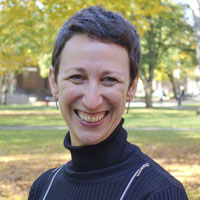 Carla Yanni
Carla Yanni
Carla Yanni is Distinguished Professor of architectural history in the Art History Department at Rutgers University, New Brunswick, New Jersey. She is the author of three monographs. Living on Campus: An Architectural History of the American Dormitory, published by the University of Minnesota Press in 2019, outlined the history of exclusion and fellowship in residence hall architecture in the United States. Her second book, The Architecture of Madness: Insane Asylums in the United States, won a Graham Foundation subvention grant and was named a 2007 “Book of Critical Interest” by the journal Critical Inquiry. She was the Ailsa Mellon Bruce Senior Fellow at the Center for Advanced Study in the Visual Arts, National Gallery of Art, Washington DC. Johns Hopkins University Press published her first book, Nature’s Museums: Victorian Science and the Architecture of Display. In 2019, she was honored with the Faculty Scholar-Teacher Award from Rutgers, a university-wide recognition for professors who creatively introduce their scholarship into the undergraduate classroom. She is currently the Second Vice President of the Society of Architectural Historians.
SAH President Victoria Young, Executive Director Pauline Saliga and Director of Communications Helena Dean will serve as ex officio members of the Strategic Planning Committee.


